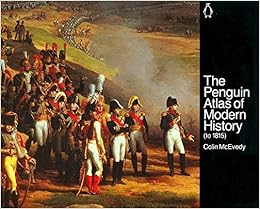
Free Downloads The Penguin Atlas Of Modern History : To 1815 (Hist Atlas)

In The Penguin Atlas of Modern History, Colin McEvedy has compiled an absorbing source of reference to the major developments of modern history from 1483 to 1815. Nearly forty maps and a detailed commentary follow the voyages of Columbus, Magellan, and Cook, the ebb of power from the Mediterranean to the Atlantic seaboard, and the protracted European struggle for control of a vastly new money economy.

Series: Hist Atlas
Paperback: 96 pages
Publisher: Penguin Books; Hist Atlas edition (November 4, 1986)
Language: English
ISBN-10: 0140511539
ISBN-13: 978-0140511536
Product Dimensions: 7.1 x 0.2 x 8.7 inches
Shipping Weight: 7.8 ounces (View shipping rates and policies)
Average Customer Review: 4.2 out of 5 stars See all reviews (13 customer reviews)
Best Sellers Rank: #101,976 in Books (See Top 100 in Books) #34 in Books > History > Historical Study & Educational Resources > Historical Maps #363 in Books > Reference > Atlases & Maps #3236 in Books > History > World

My recent interest in Early Modern European History led me to search for an atlas that would help place, geographically, the countries, cities, and towns often mentioned in the histories. Modern atlases will do in a pinch, but it can be difficult to match modern spellings with those of several hundred years ago - if indeed they still exist. I was surprised when my search turned up few recent publications. In fact, The Penguin Atlas of Modern History was the only one I could find readily available that covered the specific period of interest.The Atlas itself is a mixture of text and graphics. It is generally divided into interleaved sections that cover the World and then Europe for a given period. Almost without fail each page of text is followed by a supporting map. Most of the maps are large scale - either showing the entire world or an entire continent. It is relatively easy to locate major countries and large political units, like the Holy Roman Empire, significant trade or exploration routes, and the large population centers. But forget about finding nearly any city or town even slightly off the beaten path.The Penguin Atlas of Modern History tried to do too many things instead of just focusing on the maps. Consequently, it failed to be more than a very broad introduction to the period textually and even less so graphically. The maps provided less information than my 1950's Rand McNally Atlas of World History. And most of the historical texts covering this period provide maps on par with those in this Atlas.If you are looking for an introduction, supported with large simple maps, to the general movement of this period than I would recommend this book.
This entire series is superb and is absolutely essential for any lover of historical atlases. I have been an owner of virtually all of them for at ten years and I can honestly say that they are most read books of all that I own.The reason is their unique portability and scope. Most historical atlas are huge, heavy and expensive. They are difficult to read unless you are sitting at a table and very difficult to carry. This limits their utility (even though I still love them). Most history books have lots of dense detail about one nation or one period. Virtually none cover the broad sweep of an entire region over centuries.This atlas covers Europe, western Russia and the Mediterranean, although some of the maps are global. It starts in 1483 and finishes in 1815. In all, it has 39 maps. Each of the maps are about 30 years apart, although the exact timing varies. The focus is very heavily on Europe, even more than the rest of the series. This is a bit of a drawback, but given how important Europe was during this period, it is excusableLike all Penguin Historical Atlases, it is small, light, reasonably priced and incredibly broad in scope. These atlases offer a unique perspective on history than is otherwise impossible to achieve. Their size and weight make them perfect for travelling. Whenever I go on a trip, I take the most relevant ones with me. That way I can brush up on my history of the region.The format is extremely useful. Each two-page layout represents a specific time period. On the right is a historical map. On the left is a very brief overview of the important events that happened since the previous map. Each event usually consists of one paragraph or at most a few paragraphs, just enough to peak the interest.
The Penguin Atlas of Modern History : to 1815 (Hist Atlas) The New Penguin Atlas of Medieval History: Revised Edition (Hist Atlas) The Penguin Atlas of African History (Hist Atlas) The Penguin Historical Atlas of Ancient Rome (Hist Atlas) The Penguin Historical Atlas of the Vikings (Hist Atlas) The Penguin Historical Atlas of Ancient Egypt (Hist Atlas) The Victorian Marionette Theatre (Studies Theatre Hist & Culture) Penguin Classics Beyond Good And Evil (Penguin Modern Classics) Symbols of Power: Napoleon and the Art of the Empire Style, 1800-1815 British Campaign Medals 1815-1914 (Shire Library) 1815 The Waterloo Campaign: Wellington, His German Allies and the Battles of Ligny and Quatre Bras French Napoleonic Infantry Tactics 1792-1815 (Elite) Waterloo 1815 (2): Ligny (Campaign) The United States Army : 1812-1815 (Men-At-Arms Series, 345) Officers and Soldiers of the French Imperial Guard 1804-1815, Vol. 5: Cavalry The Torah Discourses of the Holy Tzaddik Reb Menachem Mendel of Rimanov 1745-1815 The Rhine: An Eco-biography, 1815-2000 (Weyerhaeuser Environmental Books) Art in Theory 1648-1815: An Anthology of Changing Ideas A Shopkeeper's Millennium: Society and Revivals in Rochester, New York, 1815-1837 The Times Atlas of World History (Hammond Concise Atlas of World History)



